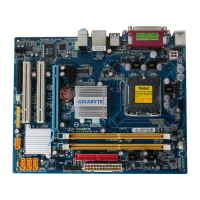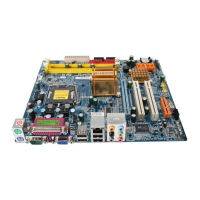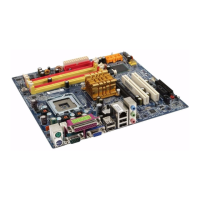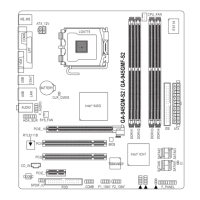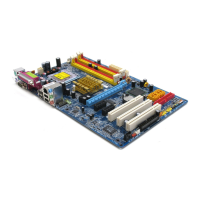Do you have a question about the Gigabyte GA-945GCM-S2L and is the answer not in the manual?
Outlines different types of documentation available for the product.
Instructions on how to find the motherboard's revision number.
Safety guidelines and procedures to follow before and during hardware installation.
Details the technical specifications of the GA-945GCM-S2L/S2C motherboard.
Describes motherboard's internal headers and back panel ports.
Information on I/O controller, system monitoring, and BIOS features.
Highlights and explains special features of the motherboard.
Information on included software applications and supported operating systems.
Specifies the physical dimensions of the motherboard.
Step-by-step instructions for installing the CPU and its cooler.
Instructions for installing RAM modules into the motherboard's memory slots.
Explains how to configure memory for dual-channel performance.
Guide to installing expansion cards like graphics or sound cards.
Details ATX power connectors and CPU/System fan headers.
Describes IDE and SATA connectors for storage devices.
Details system power LED header and CMOS battery.
Connects chassis front panel switches, LEDs, and audio to the motherboard.
How to reset BIOS and detect chassis cover removal.
Explains BIOS functions and methods for updating the BIOS.
Describes the POST screen and the function keys used to navigate BIOS.
Overview of the BIOS Setup Main Menu and its navigation keys.
Descriptions of various BIOS setup menus like Standard CMOS, Advanced BIOS, etc.
Configuring system date, time, and basic hardware settings.
Configuring boot order, CPU features, and display settings.
Configuring onboard devices like IDE, SATA, USB, and LAN.
Configuring system power-saving features and wake-up options.
Managing Plug and Play and PCI resource assignments.
Monitoring system voltages, temperatures, and fan speeds.
Adjusting CPU clock ratios, frequencies, and voltages for overclocking.
Loading Fail-Safe or Optimized default BIOS settings.
Setting BIOS access passwords for security.
Saving BIOS changes and exiting the setup program.
Instructions for installing the motherboard chipset drivers.
Lists available utilities and details the contents of the motherboard driver disk.
Displays hardware info and provides contact details for support.
Utility for system backup and restoration.
Steps to install OS and partition disk, leaving space for backup.
How to launch, backup, and restore using Xpress Recovery2.
Tools for updating the motherboard's BIOS via Q-Flash or @BIOS.
System overclocking and management utility for Windows.
Using USB flash drive to boost performance on Windows Vista.
Setup for motherboard's audio jacks and speaker configurations.
Connecting and setting up digital audio output.
Steps to set up microphone and use Sound Recorder utility.
Solutions for common problems and FAQs.
| Number of memory slots | 2 |
|---|---|
| Maximum internal memory | 4 GB |
| Processor socket | LGA 775 (Socket T) |
| Processor manufacturer | Intel |
| S/PDIF out connector | Yes |
| Number of SATA connectors | 4 |
| Number of Parallel ATA connectors | 1 |
| Controller interface type | SATA |
| Controller 2nd interface type | IDE |
| Headphone outputs | 3 |
| USB 2.0 ports quantity | USB 2.0 ports have a data transmission speed of 480 Mbps, and are backwards compatible with USB 1.1 ports. You can connect all kinds of peripheral devices to them. |
| BIOS type | AWARD |
| Audio chip | Realtek ALC662 |
| Power source type | ATX |
| Audio output channels | 5.1 channels |
| Motherboard form factor | micro ATX |
| Compatible operating systems | Windows Vista/XP/2000 |
| Bundled software | Norton Internet Security |
| LAN controller | Realtek RTL8111C |
| Networking features | Gigabit Ethernet |
| Depth | 193 mm |
|---|---|
| Width | 244 mm |

